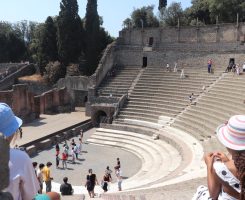
However many TV programmes, documentaries you have watched, articles you have read about Pompeii, nothing quite prepares you for the real thing.
For almost 300 years, when serious archaeological investigations began, this ancient Roman town, lying south-east of Naples in Italy’s Campania region,has been delivering an unfolding and compelling story of life and death.
Decimated when nearby Vesuvius erupted on August 24, 79CE, Pompeii has gradually been brought back to life; offering today’s visitors – it’s a draw for almost 4m of us a year – an amazing time travelling experience.
As Pompeii disappeared under waves of ash and volcanic debris, the populace tried to flee or shelter only to be killed by wave after wave of pyroclastic clouds and 700 degrees centigrade gas.
Many thousands died in the eruption, including philosopher Pliny the Elder, best known for his Natural History encyclopedia.
Grand public buildings, the world’s first Roman amphitheatre, temples dedicated to Jupiter, Juno and Venus, streets, opulent villas, homes and businesses were buried under more than 20ft of volcanic rubble.
And there they stayed, frozen-in-time, until systematic excavations began in 1738, a move that marked the beginnings of the modern
science of archaeology.
Digging unearthed the preserved remains of people sheltering from the eruption; others lay buried as they fled and loaves of bread were found still in the ovens at bakeries
Wandering down streets and into homes, baths and businesses – including brothels with their famous frescoes – is to follow in the footsteps of the original residents of Pompeii.
Walking around Pompeii, covering a 163-acre site and surrounded by two miles of walls, and soaking in a uniquely revived environment is an unforgettable experience.
Our visit was heralded by extensive and persistent forest fires on Mount Vesuvius – a constant reminder of the power of Mother Nature.
Designated a UNESCO World Heritage Site in 1997, about a third of Pompeii still remains untouched by the archaeologists.
But it’s a time capsule that is still giving up secrets.
Earlier this year archaeologists discovered a sumptuous private bathhouse – potentially the largest ever found there – complete with hot, warm and cold rooms, exquisite artwork, and a huge plunge pool.
The Pompeii Archaeological Park has just unveiled the restored Garden of Hercules, named for a statue of the mythical hero uncovered at the site.
It has been freshly planted with 1,200 violets, 1,000 ruscus plants, and 800 antique roses, as well as vines and cherry and cotton apple trees.
The botanical display is intended to mirror how the garden appeared 2,000 years ago, based on the findings of botanist Wilhelmina Jashemski, who identified pollen, spores, and plant fossils in the area in the 1950s.
If you get the chance to visit Pompeii – don’t hesitate.




